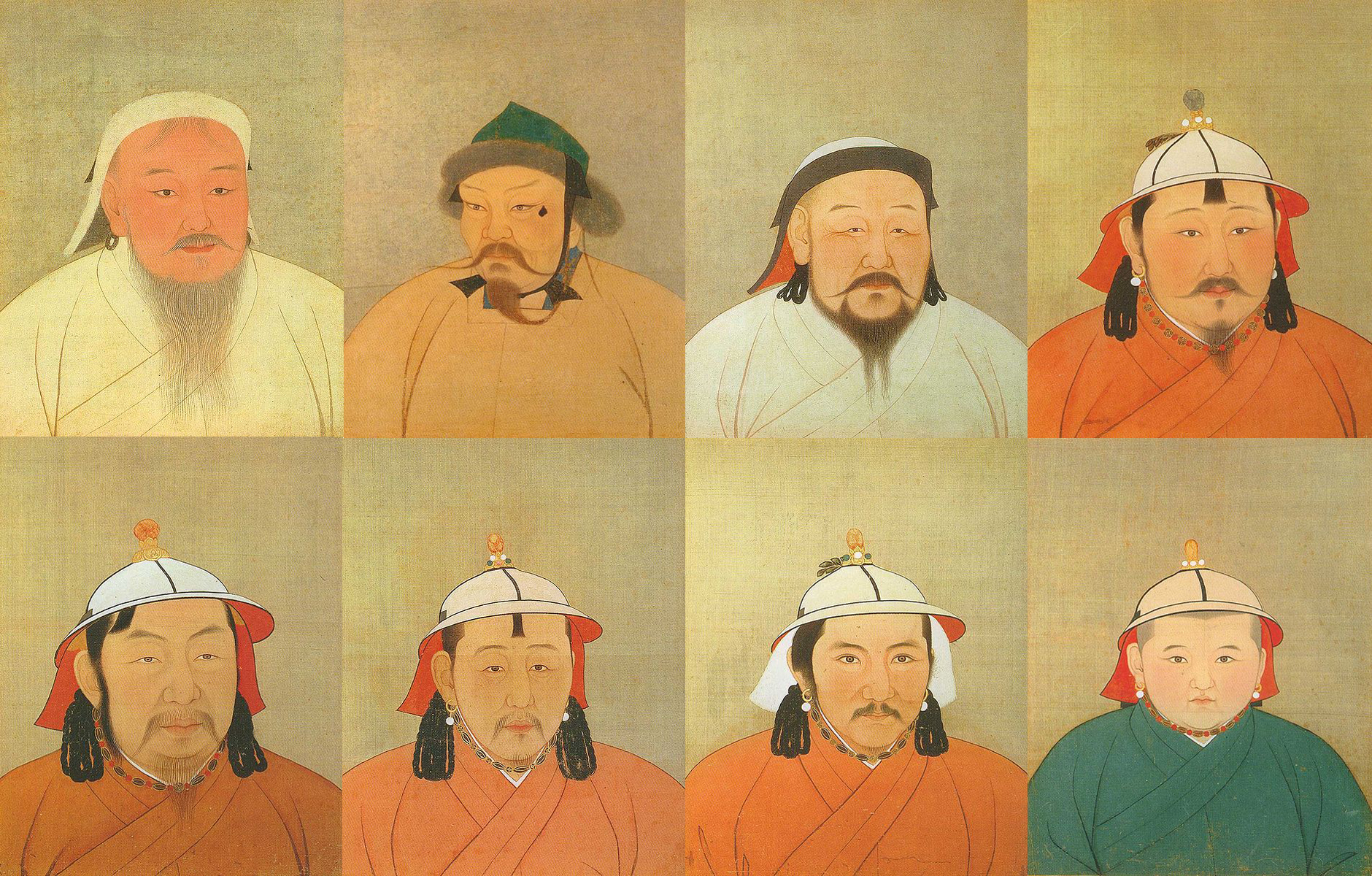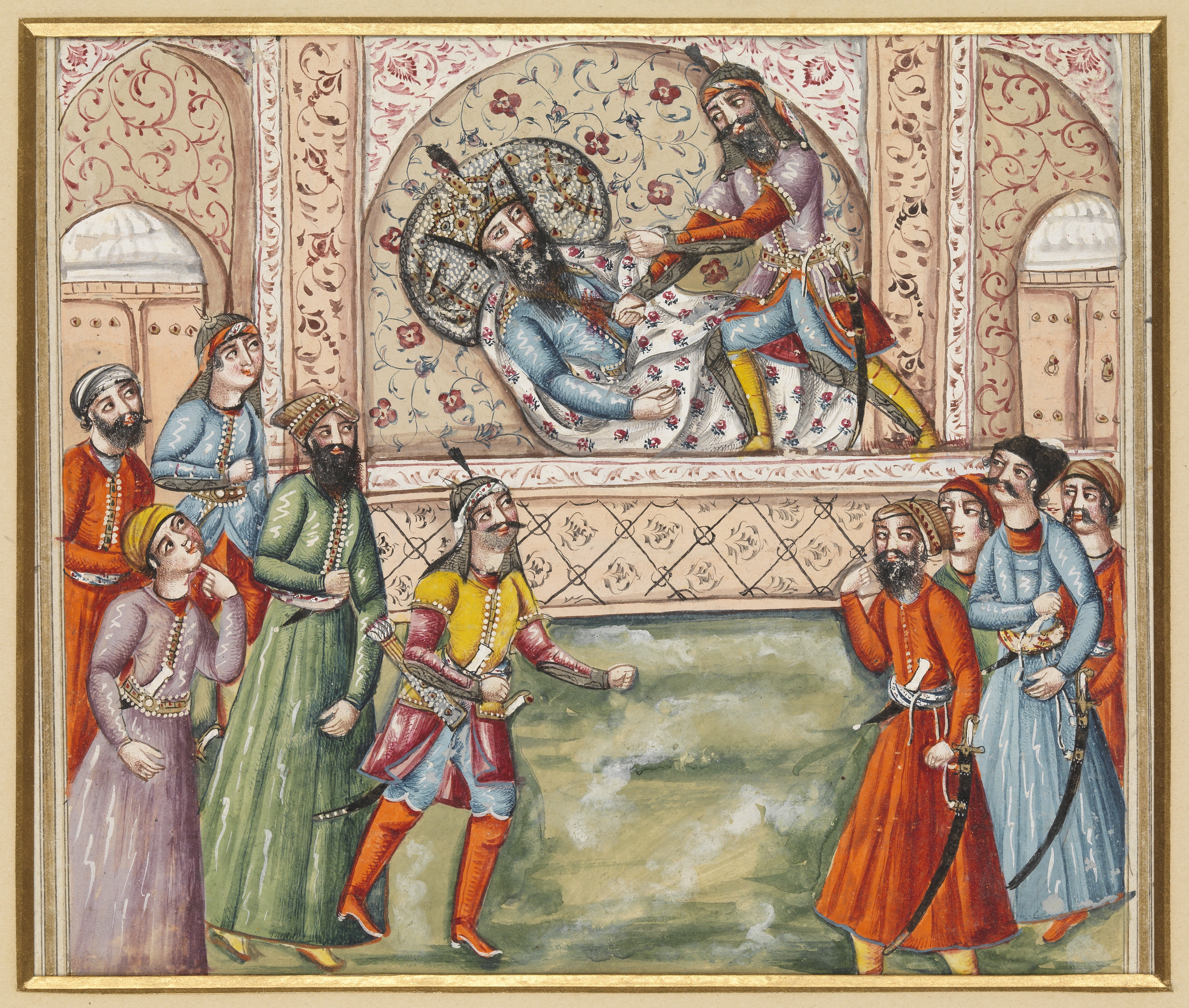|
Kara-Khanid Khanate
The Kara-Khanid Khanate (; zh, t=喀喇汗國, p=Kālā Hánguó), also known as the Karakhanids, Qarakhanids, Ilek Khanids or the Afrasiabids (), was a Karluk Turkic khanate that ruled Central Asia from the 9th to the early 13th century. The dynastic names of Karakhanids and Ilek Khanids refer to royal titles with Kara Khagan being the most important Turkic title up until the end of the dynasty. The Khanate conquered Transoxiana in Central Asia and ruled it independently between 999 and 1089. Their arrival in Transoxiana signaled a definitive shift from Iranic to Turkic predominance in Central Asia, yet the Kara-khanids gradually assimilated the Perso-Arab Muslim culture, while retaining some of their native Turkic culture. The Khanate split into the Eastern and Western Khanates in the 1040s. In the late 11th century, they came under the suzerainty of the Seljuk Empire followed by the Qara Khitai (Western Liao dynasty) who defeated the Seljuks in the Battle of Qatwan in 11 ... [...More Info...] [...Related Items...] OR: [Wikipedia] [Google] [Baidu] |
Khaganate
A khanate ( ) or khaganate refers to historic polity, polities ruled by a Khan (title), khan, khagan, khatun, or khanum. Khanates were typically nomadic Mongol and Turkic peoples, Turkic or Tatars, Tatar societies located on the Eurasian Steppe, and politically equivalent in status to chiefdom, kinship-based chiefdoms and Feudalism, feudal Monarchy, monarchies. Khanates and khaganates were organised Tribe, tribally, where leaders gained power on the support and loyalty of their warrior subjects, gaining tribute from subordinates as realm funding. In comparison to a khanate, a khaganate, the realm of a khagan, was a Nomadic empire, large nomadic state maintaining subjugation over numerous smaller khanates. The title of khagan, translating as "Khan of the Khans", roughly corresponds in status to that of an emperor. Mongol khanates Mongol Empire (1206–1368) The Mongol Empire was the largest steppe nomadic Khaganate as well as List of largest empires, second largest empire and t ... [...More Info...] [...Related Items...] OR: [Wikipedia] [Google] [Baidu] |
Khagan
Khagan or Qaghan (Middle Mongol:; or ''Khagan''; ) or zh, c=大汗, p=Dàhán; ''Khāqān'', alternatively spelled Kağan, Kagan, Khaghan, Kaghan, Khakan, Khakhan, Khaqan, Xagahn, Qaghan, Chagan, Қан, or Kha'an is a title of empire, imperial rank in Turkic languages, Turkic, Mongolic languages, Mongolic, and some other languages, equal to the status of emperor and someone who rules a khaganate (empire). The female equivalent is Khatun. It may also be translated as "Khan (title), Khan of Khans", equivalent to King of Kings. In Bulgarian, the title became known as ''Khan'', while in modern Turkic, the title became ''Khaan'' with the ''g'' sound becoming almost silent or non-existent; the ''ğ'' in modern Turkish language, Turkish ''Kağan'' is also silent. After the division of the Mongol Empire, monarchs of the Yuan dynasty and the Northern Yuan held the title of ''Khagan''. ''Kağan, Hakan'' and ''Kaan'', Turkish language, Turkish equivalents of the title are common Tur ... [...More Info...] [...Related Items...] OR: [Wikipedia] [Google] [Baidu] |
Khwarazmian Empire
The Khwarazmian Empire (), or simply Khwarazm, was a culturally Persianate society, Persianate, Sunni Muslim empire of Turkic peoples, Turkic ''mamluk'' origin. Khwarazmians ruled large parts of present-day Central Asia, Afghanistan, and Iran from 1077 to 1231; first as vassals of the Seljuk Empire and the Qara Khitai (Western Liao dynasty), and from circa 1190 as independent rulers up until the Mongol conquest of the Khwarazmian Empire, Mongol conquest in 1219–1221. The date of the founding of the state remains debatable. The dynasty that ruled the empire was founded by Anushtegin Gharchai, Anush Tigin (also known as Gharachai), initially a Turkic slave of the rulers of Gharchistan, later a Mamluk in the service of the Seljuks. However, it was Atsiz, Ala ad-Din Atsiz (r. 1127–1156), descendant of Anush Tigin, who achieved Khwarazm's independence from its neighbors. The Khwarazmian Empire eventually became the most powerful state in the lands around Persia, defeating the S ... [...More Info...] [...Related Items...] OR: [Wikipedia] [Google] [Baidu] |
Battle Of Qatwan
The Battle of Qatwan () was fought in September 1141 between the Qara Khitai (Western Liao dynasty) and the Seljuk Empire and its vassal-state the Kara-Khanid Khanate. The battle ended in a decisive defeat for the Seljuks, signaling the beginning of the end of the Great Seljuk Empire. Background The Khitans were people of the Liao dynasty who moved west from Northern China when the Jin dynasty invaded and destroyed the Liao dynasty in 1125. Liao remnants were led by Yelü Dashi who took the Eastern Karakhanid capital of Balasagun. In 1137, they defeated the Western Karakhanids, a vassal of the Seljuks, at Khujand, and the Karakhanid ruler Mahmud II appealed to his Seljuk overlord Ahmed Sanjar for protection. In 1141, Sanjar with his army arrived in Samarkand. The Kara-Khitans, who were invited by the Khwarazmians (then also a vassal of the Seljuks) to conquer the lands of the Seljuks, and also responding to an appeal to intervene by the Karluks who were involved in a conf ... [...More Info...] [...Related Items...] OR: [Wikipedia] [Google] [Baidu] |
Muslim Culture
Islamic cultures or Muslim cultures refers to the historic cultural practices that developed among the various peoples living in the Muslim world. These practices, while not always religious in nature, are generally influenced by aspects of Islam, particularly due to the religion serving as an effective conduit for the inter-mingling of people from different ethnic/national backgrounds in a way that enabled their cultures to come together on the basis of a common Muslim identity. The earliest forms of Muslim culture, from the Rashidun Caliphate to the Umayyad Caliphate and early Abbasid Caliphate, was predominantly based on the existing cultural practices of the Arabs, the Byzantines, and the Persians. However, as the Islamic empires expanded rapidly, Muslim culture was further influenced and assimilated much from the Iranic, Pakistani, Bangladeshi, Indian, Caucasian, Turkic, Malay, Somali, Berber, and Indonesian cultures. Owing to a variety of factors, there are var ... [...More Info...] [...Related Items...] OR: [Wikipedia] [Google] [Baidu] |
Transoxiana
Transoxiana or Transoxania (, now called the Amu Darya) is the Latin name for the region and civilization located in lower Central Asia roughly corresponding to eastern Uzbekistan, western Tajikistan, parts of southern Kazakhstan, parts of Turkmenistan and southern Kyrgyzstan. The name was first coined by Alexander the Great in the 4th century BC when Alexander's troops conquered the region. The region may have had a similar Greek name in the days of Alexander the Great, but the earlier name is no longer known. Geographically, it is the region between the rivers Amu Darya to its south and the Syr Darya to its north. The region of Transoxiana was one of the satrapies (provinces) of the Achaemenid Empire of Persia under the name Sogdia. It was defined within the classical world of Persia to distinguish it from Iran proper, especially its northeastern province of Khorasan, a term originating with the Sasanians, although early Arab historians and geographers tended to subs ... [...More Info...] [...Related Items...] OR: [Wikipedia] [Google] [Baidu] |
Central Asia
Central Asia is a region of Asia consisting of Kazakhstan, Kyrgyzstan, Tajikistan, Turkmenistan, and Uzbekistan. The countries as a group are also colloquially referred to as the "-stans" as all have names ending with the Persian language, Persian suffix "-stan" (meaning ) in both respective native languages and most other languages. The region is bounded by the Caspian Sea to the southwest, European Russia to the northwest, China and Mongolia to the east, Afghanistan and Iran to the south, and Siberia to the north. Together, the five Central Asian countries have a total population of around million. In the pre-Islamic and early Islamic eras ( and earlier) Central Asia was inhabited predominantly by Iranian peoples, populated by Eastern Iranian-speaking Bactrians, Sogdians, Khwarezmian language, Chorasmians, and the semi-nomadic Scythians and Dahae. As the result of Turkic migration, Central Asia also became the homeland for the Kazakhs, Kyrgyzs, Volga Tatars, Tatars, Turkmens, ... [...More Info...] [...Related Items...] OR: [Wikipedia] [Google] [Baidu] |
Khanate
A khanate ( ) or khaganate refers to historic polity, polities ruled by a Khan (title), khan, khagan, khatun, or khanum. Khanates were typically nomadic Mongol and Turkic peoples, Turkic or Tatars, Tatar societies located on the Eurasian Steppe, and politically equivalent in status to chiefdom, kinship-based chiefdoms and Feudalism, feudal Monarchy, monarchies. Khanates and khaganates were organised Tribe, tribally, where leaders gained power on the support and loyalty of their warrior subjects, gaining tribute from subordinates as realm funding. In comparison to a khanate, a khaganate, the realm of a khagan, was a Nomadic empire, large nomadic state maintaining subjugation over numerous smaller khanates. The title of khagan, translating as "Khan of the Khans", roughly corresponds in status to that of an emperor. Mongol khanates Mongol Empire (1206–1368) The Mongol Empire was the largest steppe nomadic Khaganate as well as List of largest empires, second largest empire and t ... [...More Info...] [...Related Items...] OR: [Wikipedia] [Google] [Baidu] |
Turkic Peoples
Turkic peoples are a collection of diverse ethnic groups of West Asia, West, Central Asia, Central, East Asia, East, and North Asia as well as parts of Europe, who speak Turkic languages.. "Turkic peoples, any of various peoples whose members speak languages belonging to the Turkic subfamily...". "The Turkic peoples represent a diverse collection of ethnic groups defined by the Turkic languages." According to historians and linguists, the Proto-Turkic language originated in Central-East Asia, potentially in the Altai-Sayan region, Mongolia or Tuva.: "The ultimate Proto-Turkic homeland may have been located in a more compact area, most likely in Eastern Mongolia": "The best candidate for the Turkic Urheimat would then be northern and western Mongolia and Tuva, where all these haplogroups could have intermingled, rather than eastern and southern Mongolia..." Initially, Proto-Turkic speakers were potentially both hunter-gatherers and farmers; they later became nomadic Pastoralism, ... [...More Info...] [...Related Items...] OR: [Wikipedia] [Google] [Baidu] |
Karluks
The Karluks (also Qarluqs, Qarluks, Karluqs, , Qarluq, Para-Mongolic languages, Para-Mongol: Harluut, zh, s=葛逻禄, t=葛邏祿 ''Géluólù'' ; customary phonetic: ''Gelu, Khololo, Khorlo'', , ''Khallokh'', ''Qarluq'') were a prominent nomadic Turkic peoples, Turkic tribal confederacy residing in the regions of Kara-Irtysh (Black Irtysh) and the Tarbagatai Mountains west of the Altay Mountains in Central Asia. The majority of Uzbeks and Uyghurs indeed descend from Karluk tribes, and their languages are part of the Karluk subgroup, making them linguistically and historically distinct from other Turkic peoples like Kazakhs (Kipchaks, Kipchak) or Turkmens (Oghuz Turks, Oghuz). Karluks were known as a coherent ethnic group (with autonomous status within the Göktürks, Göktürk khaganate and an independent one in their subsequent states of the Karluk Yabghu, Karluk yabghu, Karakhanids and Qarlughids) before being absorbed ... [...More Info...] [...Related Items...] OR: [Wikipedia] [Google] [Baidu] |
Afrasiab
Afrasiyab ( ''afrāsiyāb''; ; Middle-Persian: ''Frāsiyāv, Frāsiyāk'') is the name of the mythical king and hero of Turan. He is the main antagonist of the Persian epic ''Shahnameh'', written by Ferdowsi. Name and origin ''Afrā'' is the poetic form of the Persian word ''Farā'' (itself a poetic word), which means "beyond, further", while Sīāb comes from ''sīāh'' meaning "black" and ''Āb'' meaning "water", "river", "sea" (depending on the context). Scholars see it as a distortion of the Tajik ''Parsīāb'' (from Sogdian ''Paršvāb''), meaning "above the black river" a reference to the Sīāhāb or Sīāb.According to the ''Shahnameh'' (''Book of Kings''), by the Persian epic poet Ferdowsi, Afrasiab was the king and hero of Turan and an archenemy of Iran. In Iranian mythology, Afrasiab is considered by far the most prominent of all Turanian kings; he is a formidable warrior, a skilful general, and an agent of Ahriman, who is endowed with magical powers of deception to ... [...More Info...] [...Related Items...] OR: [Wikipedia] [Google] [Baidu] |






